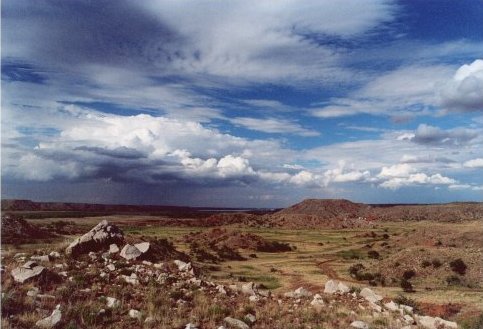 |
 | |
  | |
|
|
|
|
Alibates Flint Quarries National Monument
Nature & Science
|
|
|
|
|
|
 |
 |
| NPS | | The Alibates flint comes in an array of colors. |
 |
The Alibates flint is more correctly called agatized dolomite, or silicified dolomite. Many archeologists also refer to it as Alibates chert because of it's striking colors. The colors in the flint are caused by trace mineral elements within the silica. The most common colors of red, orange and yellow are caused by iron; blues and deep greens are usually caused by manganese.
There are several theories as to how the flint formed within the dolomite. The most widely accepted theory is that about 670,000 years ago volcanic eruptions occurred in or around what is now called the Yellowstone Country of Wyoming. The resulting silica rich ash drifted upon and above the Permian era dolomite and as slightly acidic rainwater peculated through the ash the silica was able to go into solution. As it soaked into the much older dolomite, the calcium carbonate was washed out leaving the precipitate, silica dioxide (flint or chert), behind.
|
 |
| NPS | | The Alibates Flint Quarries lie within the Canadian Breaks formed by the Canadian River. |
 |
The Alibates flint is located only within the eight foot thick dolomite caprock layer found throughout the region. Even then, the flint is only found in specific areas, where conditions were favorable for it's formation. The dolomite caprock, which is highly resistant to erosion, protects the softer, more erodable, underlying layers. The result is the 'Canadian Breaks' which is a broken landscape, formed mostly by water erosion, contained within one of the flattest surfaces on the planet, the southern Great Plains of central North America. As the dolomite caprock finally breaks down, large boulders are left. Where the capstone is still intact, mesas and buttes often appear.
|
|  |  |

|
 |
|
|
|
|
|
 |
|
Did You Know?
Florissant Fossil Beds National Monument is actively involved in fire mitigation and conducts prescribed burns every winter.
|
|
|
|
Last Updated: November 16, 2007 at 14:22 EST |






